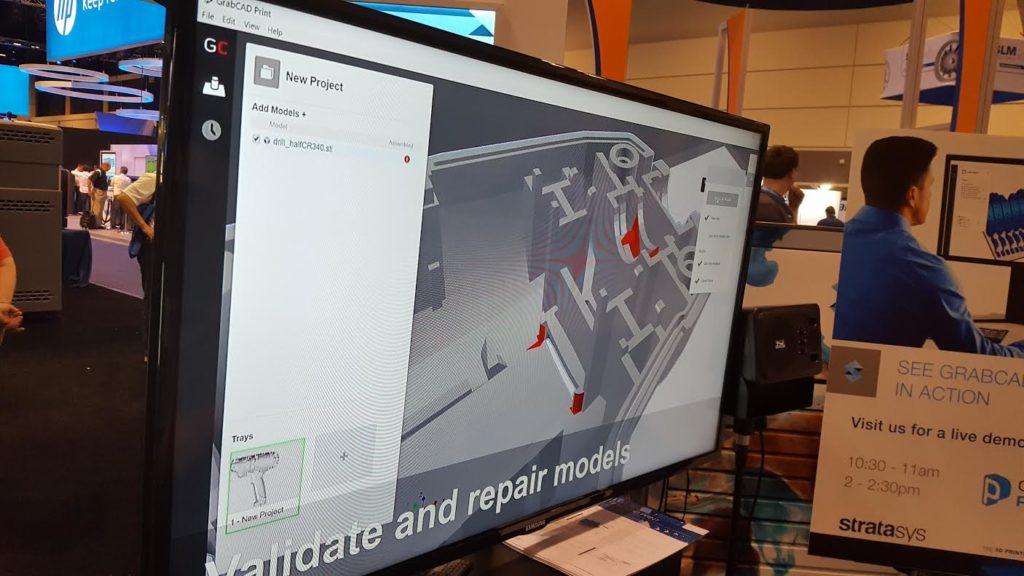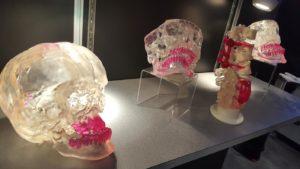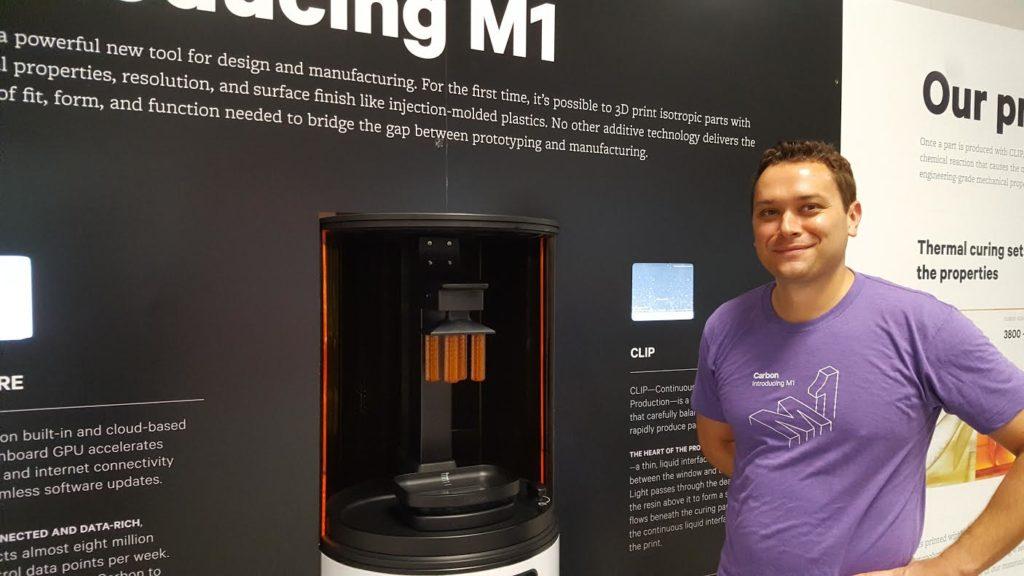 It’s the worst-kept secret here at 3DPrint.com: RAPID 2016 was a busy time! Clare and I were kept on our toes two weeks ago in Orlando, where we were treated to the unique-to-shows experience of being literally surrounded by the latest in incredible additive manufacturing technology.
It’s the worst-kept secret here at 3DPrint.com: RAPID 2016 was a busy time! Clare and I were kept on our toes two weeks ago in Orlando, where we were treated to the unique-to-shows experience of being literally surrounded by the latest in incredible additive manufacturing technology.
I was fortunate to sit down with some big names in the industry at RAPID this year, including representatives from Materialise, Stratasys, 3D Systems, and Carbon — and I’m thrilled to now share with our readers some of the exciting developments I heard about first-hand!
Materialise
One of the biggest names in 3D software, Materialise offers a dizzying array of the latest solutions for a number of fields that can benefit from 3D technologies. One company now benefiting from a partnership with Materialise, with its 25 years of expertise, is HP Inc., which at RAPID officially unveiled their first 3D printer. We’ve seen that partnerships have played a critical role in the development of the HP Jet Fusion 3D printing ecosystem, and since the early days of its development, Materialise has been right there.
Vice President and General Manager of Materialise NA Bryan Crutchfield sat down with me at RAPID to discuss Materialise’s partnership with HP, and some of what this has entailed. They key word here for Materialise is backbone — the company offers a key array of backbone products, such as the Magics suite, that “provide connectivity and seamless integration into the HP workflow,” Crutchfield told me. Magics can “help with the interesting questions,” from “front end to platform to slicing” in the end-to-end workflow. Materialise will be a beta user for HP’s equipment later this year.
In what has become one of my favorite questions regarding the latest technology from HP, I asked Crutchfield was his favorite part of the new tech was:
“I think that the promise that it brings with cycle time and the vast, 30 years of experience they have producing commercial printers from the 2D world, that brings a level of expertise in repeatability and predictability that I think are going to bring interesting applications to the industry. If they truly do achieve the price points that they’re talking about it’s just going to be a paradigm shift in the number of applications that will become eligible for 3D printing and end-part use manufacturing.”
Noting that the verticals where HP is beginning focus match firmly with those that Materialise has long-established expertise in, Crutchfield again underscored the fit between these two collaborative partners. The two companies do indeed have a lot in common, as HP’s Stephen Nigro echoed as well in a press release:
“3D printing will bring tremendous benefit to manufacturing, helping to make it faster and less expensive. Matching the HP Jet Fusion 3D Printing Solution with Materialise software provides our customers the best-in-class solution for industrial 3D printing.”
Stratasys
Earlier in May, Stratasys announced the upcoming beta for the GrabCAD Print app, and at RAPID had a handy demonstration ready to go, highlighting the app’s impressive capabilities. At the Stratasys booth, Vice President of Product and Marketing Paul Giaconia introduced me to some of the concepts behind the release.
“Software is a key investment we need to make,” Giaconia told me of the background on the idea to launch GrabCAD Print. “It’s a connected world now.”
He told me that some of the key disruptions required for 3D printing to evolve into the fabled next Industrial Revolution lie in realism, connectivity, and accessibility. Digitization in preparing files for 3D print can take the digital to the physical, and therein lies the key — and, Giaconia told me, “GrabCAD Print addresses these three points.” With GrabCAD Print, accessibility lies in the web-based, mobile- and desktop-friendly setup that makes human/machine interfacing simple; connectivity provides resources, connects all available printers, and offers business intelligence; and realism allows in job preparation that can read any CAD file directly, with native CAD access allowing users to skip a typical step. Giaconia also expressed some surprise that connectivity isn’t already there in the industry, and that this effort is based in stepping back to tie all the pieces together.
“Industry has said to the customer, ‘you figure it out’ so far. But we can do better than that,” Giaconia said.
I was treated to a demo of the app by GrabCAD’s Roger Maranan next, so I could watch just how intuitive GrabCAD Print actually is. The demo he showed me was connected to all of the 3D printers back in Eden Prairie, and Maranan could have easily started a print job back in Minnesota from the exhibit floor in Orlando. GrabCAD Print offers a layer-by-layer view of a file, so the preview shows actual layers and settings, rather than a simple 2D glance. An analysis mode detects and highlights any errors, and supports can be turned on or off in preview.
3D Systems
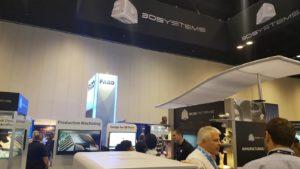 Trade shows offer not only great access to technologies, but also to the names in my inbox, as at the 3D Systems booth, Clare and I had the opportunity to meet and chat with Timothy Miller, 3DS’ Director of Corporate Communications and Public Relations. Miller first toured us through 3DS’ booth, which was, as promised, extensive and full of some truly impressive machines and models. The ProJet MJP 2500, released in April, was on display at the booth, offering “a new price point, easy user experience, easy clean, hands-free post-processing capabilities, office-friendly” 3D printing experience. Office-friendly, indeed; though I’d seen photos before of the ProJet MJP 2500, it did catch me off-guard because it was a bit more space-friendly than I had anticipated before.
Trade shows offer not only great access to technologies, but also to the names in my inbox, as at the 3D Systems booth, Clare and I had the opportunity to meet and chat with Timothy Miller, 3DS’ Director of Corporate Communications and Public Relations. Miller first toured us through 3DS’ booth, which was, as promised, extensive and full of some truly impressive machines and models. The ProJet MJP 2500, released in April, was on display at the booth, offering “a new price point, easy user experience, easy clean, hands-free post-processing capabilities, office-friendly” 3D printing experience. Office-friendly, indeed; though I’d seen photos before of the ProJet MJP 2500, it did catch me off-guard because it was a bit more space-friendly than I had anticipated before.
3DS’ Barry Ader and Scott Bender were on-hand to show Clare and me the general ropes of the ProJet MJP 2500, and to show us around the materials options available. The ProJet MJP 2500 is available in standard black and white materials, while the 2500+ can also use crystal and elastomeric materials, with black, white and clear available in rigid materials, and elastomeric available in natural and black. Ader and Bender also told us that four of their partner companies were at RAPID with this printer.
After touring the booth and checking out the 2500, as well as the huge ProX DMP 320, Clare and I sat down with Miller to discuss more about 3DS, including their entire ecosystem.
“We have built a 3D printing ecosystem over the past 30 years,” he told us, “printers, software, services and a vast partner network. You can clearly see that ecosystem here [at RAPID] with more than 20 of our partners showcasing advanced applications of our technology on the show floor. People don’t just want a printer, they want a solution. We are focused on providing end-to-end solutions for professional and industrial customers.”
3DS is set on providing solutions, and Miller highlighted some particular bright areas that the company is seeing. He noted that, with Chuck Hull driving it right along, Figure 4 Technology is the future of SLA. Hull, recently honored alongside his original SLA-1 3D printer, remains incredibly active at 3D Systems, spurring more development. Figure 4 Technology allows for reactive materials, and is modular, and can be in automated manufacturing facilities. Other bright spots ahead for 3DS include healthcare, where entire workflows feature proprietary approaches, and where the SLS side may see development, such as in the creation of surgical guides.
Carbon
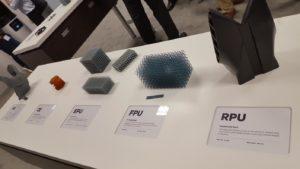 One of the few times I left the show floor was to go into a different room — where Carbon had set up shop. Across the hall from the hustle and bustle of the main exhibit hall, Carbon’s room was certainly still not far from the crowds, as the room attracted visitors aplenty. With a few M1 3D printers set up around the room, everyone could get a nice look at the hardware, as well as some test prints created with various materials the company has developed, which offer unique benefits in 3D printing. To guide me through all of this, Carbon’s Vice President of Materials, Jason Rolland, offered his insights on what was going on in the room and how the materials were shaping up (pun intended), since the highly-anticipated 3D printer’s release just in April.
One of the few times I left the show floor was to go into a different room — where Carbon had set up shop. Across the hall from the hustle and bustle of the main exhibit hall, Carbon’s room was certainly still not far from the crowds, as the room attracted visitors aplenty. With a few M1 3D printers set up around the room, everyone could get a nice look at the hardware, as well as some test prints created with various materials the company has developed, which offer unique benefits in 3D printing. To guide me through all of this, Carbon’s Vice President of Materials, Jason Rolland, offered his insights on what was going on in the room and how the materials were shaping up (pun intended), since the highly-anticipated 3D printer’s release just in April.
“The industry is pretty jaded on the longevity and durability of 3D printed parts,” Rolland told me, “which is why the feedback we’re getting back from customers is so promising. We’re in a whole different world of materials. Getting feedback after 400K compression tests and 7 months of field testing on BMW cars is really critical.”
The M1 3D printer is already bringing its super-fast CLIP technology to fields including aerospace, medical, footwear, orthotics, and automotive.
“It’s a fun time for the company because we’re realizing this can change manufacturing, change how things are made, and that’s very exciting,” Rolland explained.
 The enthusiasm from the team and the crowd was palpable — and contagious. As I handled several of the test prints made with various materials, Rolland filled me in how everything has been coming along since the printers started making their way to customers. Apparently, news is good. As a Cleveland native, I was heartened to hear that the Rust Belt in particular has seen many customers, particularly in Cleveland and Detroit. Rolland noted that one company, in fact, just purchased its third CLIP printer. With about 30 of the printers out there now, Rolland told me, the plan for this year is to ramp things up, so next year there will be hundreds out there, noting that “the amount of excitement has been really great.”
The enthusiasm from the team and the crowd was palpable — and contagious. As I handled several of the test prints made with various materials, Rolland filled me in how everything has been coming along since the printers started making their way to customers. Apparently, news is good. As a Cleveland native, I was heartened to hear that the Rust Belt in particular has seen many customers, particularly in Cleveland and Detroit. Rolland noted that one company, in fact, just purchased its third CLIP printer. With about 30 of the printers out there now, Rolland told me, the plan for this year is to ramp things up, so next year there will be hundreds out there, noting that “the amount of excitement has been really great.”
“We don’t want to hide from feedback,” Rolland told me plainly, going on to explain that they first went after people who had been working with 3D printing technologies for 20-30 years to work with the M1. “Tapping in to the heavy users of 3D printing first was a huge step for us.”
When it comes down to it, of course, it’s all about what can be made on these machines. Rolland and the rest of the team at Carbon are certainly keeping that in mind, as he noted that:
“People don’t care about oxygen quenching, they care about the part. As long as we stay focused on that I think we have a very bright future in this industry.”
The future is, indeed, looking bright for all of these companies. While it can be easy to get tied up in the cleverness of a new product or the speed of a new technology, the representatives I spoke with at each of these booths/rooms drove home a key point: it’s about what can happen. The technology is of course incredible, and very interesting academically — but the key to its use, to this elusive and long-promised next Industrial Revolution, lies in use. With end-use parts being able to roll off of print beds and materials development beginning to keep pace with the machines that use them, it seems that some of the biggest names in 3D printing today certainly have their heads in the game.
And I, for one, can’t wait to see where they are at this time next year, in five years, in ten years. Development is picking up steam, and additive manufacturing is very definitely here to stay.
Check out more photos from my time at RAPID here. Discuss further over in the Conversations at RAPID 2016 forum at 3DPB.com.
[All photos taken on-site at RAPID by Sarah Goehrke for 3DPrint.com]Subscribe to Our Email Newsletter
Stay up-to-date on all the latest news from the 3D printing industry and receive information and offers from third party vendors.
Print Services
Upload your 3D Models and get them printed quickly and efficiently.
You May Also Like
3D Printing News Briefs, June 11, 2025: Sustainability, Automotive Tooling, & More
We’re starting with sustainability news in today’s 3D Printing News Briefs, as EOS has strengthened its commitment on climate responsibility, and Zestep is making 3D printing filament out of eyewear...
3D Printing 50 Polymer Stand-In Parts for Tokamaks at the PPPL & Elytt Energy
Of all the world’s things, a tokamak is one of the hardest, most complex, expensive and exacting ones to make. These fusion energy devices make plasma, and use magnets to...
3D Printing News Briefs, May 17, 2025: Color-Changing Materials, Humanoid Robot, & More
We’re covering research innovations in today’s 3D Printing News Briefs! First, Penn Engineering developed 3D printed materials that change color under stress, and UC Berkeley researchers created an open source,...
Firehawk Aerospace Partners with JuggerBot 3D, Gets $1.25M from AFWERX for 3D Printed Propellants
Texas-based Firehawk Aerospace, an advanced energetic materials firm that works with aerospace and defense applications, announced a strategic partnership with JuggerBot 3D, an Ohio-based large-format 3D printer manufacturer. Together, the...



